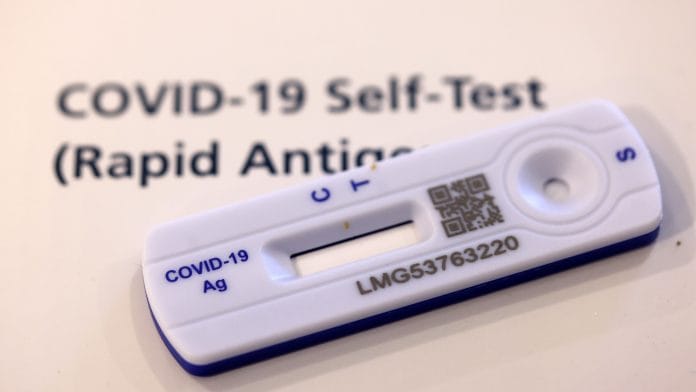Bengaluru: As Covid cases continue to rise exponentially across the country, epidemiologists are pushing for more use of at-home rapid testing kits, which are capable of providing results within 15 minutes. Experts say these tests are more reliable for detecting the highly contagious Omicron variant because it multiplies rapidly inside the body upon infection.
The testing kit contains a swab along with testing materials and a test device. The swabs are typically taken from the nose, mouth or throat.
The device functions similar to a pregnancy test kit, with two lines indicating positive results. The test can be taken immediately if a person exhibits symptoms and in case exposure is suspected, the test can be taken the next day.
ThePrint answers the frequently asked questions about these rapid tests and how the kits should be used:
What are rapid tests?
Rapid antigen tests are stick-test kits that can detect the presence of live viruses in the body. Unlike RT-PCR tests which take a day to deliver results, these tests can detect positive cases within 15 minutes. They work by detecting surface proteins or antigens on the live virus, typically the spike protein of the coronavirus.
Rapid tests are effective when an infected person has a high viral load or quantity of multiplied virus in the body. Consequently, they could be ineffective during the first couple of days after infection.
A testing kit contains a swab along with testing materials and a test device. The swabs are typically inserted onto the nasopharyngeal (nose) or oropharyngeal (mouth or throat). Recent studies have indicated that viral loads peak faster in saliva.
The device operates on similar lines to a pregnancy test kit. Upon putting the sample, the control line first turns red to indicate that the device is not faulty. A subsequent red line appears in case the test sample is positive.
As in the case of the RT-PCR test, the rapid tests also can’t detect antigens from vaccination. However, unlike RT-PCR, rapid tests do not turn positive for dead virus being shed post the disease. This happens because rapid tests require an extremely high quantity of virus that is achievable only through replication.
Also read: Paracetamol, pain killers not recommended for children after Covaxin shot, says Bharat Biotech
Where are the kits available?
In India, rapid test kits can be purchased at local pharmacies and through online retailers. To date, 145 antigen-based rapid test kits have been validated (including 30 revalidations). by The Indian Council of Medical Research (ICMR). The US Food and Drug Administration approved tests are also allowed in the country.
When should a rapid test be taken?
Rapid tests detect surface proteins on the live virus when the quantity of virus is high. In infected patients, this occurs anywhere from a day to four days from exposure — also the period when symptoms begin to show.
If the test comes negative, it is recommended to follow up with another test after a day. If the symptoms persist or exposure is strongly suspected, taking daily tests or an RT-PCR is recommended.
If a person intends to socialise and is unsure if they’re infected, the ideal time to test themselves would be an hour or two before meeting another person or attending a gathering.
Also read: Cough or fever first? Covid variants can make symptoms appear in different order, US study says
What does a negative result mean?
Since the rapid tests detect high viral load, the tests could produce a false negative if an infection has not achieved the required threshold of viral quantity.
Given that majority of India’s urban population has been vaccinated, and many also have a previous Covid history, early symptoms are likely to be the immune response rather than those caused by the virus. In such cases, the test could produce a false negative, with the likelihood of producing a positive after a few hours or a day later. The chances of false negatives are higher for asymptomatic infections.
What does a positive result mean?
Most guidelines say that an infected person must isolate for 7-10 days or until two consecutive negative tests.
Since early results for symptomatic people could be from the immune response, a person is likely to become contagious only subsequent to initial symptoms.
Public health experts are calling to raise the isolation period to 10 days instead of shortening it as people are likely to be infectious longer.
Most tests can also typically indicate the degree of viral load by how they peak. A higher viral load turns darker while a lower load remains a lighter shade of the indicator (typically red).
(Edited by Monami Gogoi)
Also read: Antibody cocktails, oral pills: These are the Covid treatments available as Omicron surges






